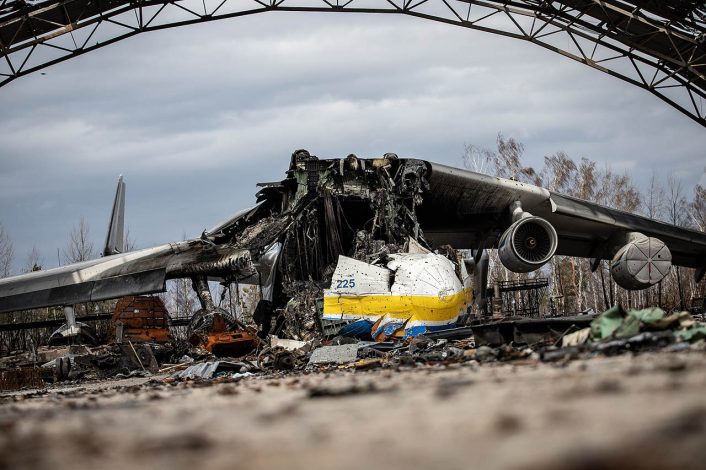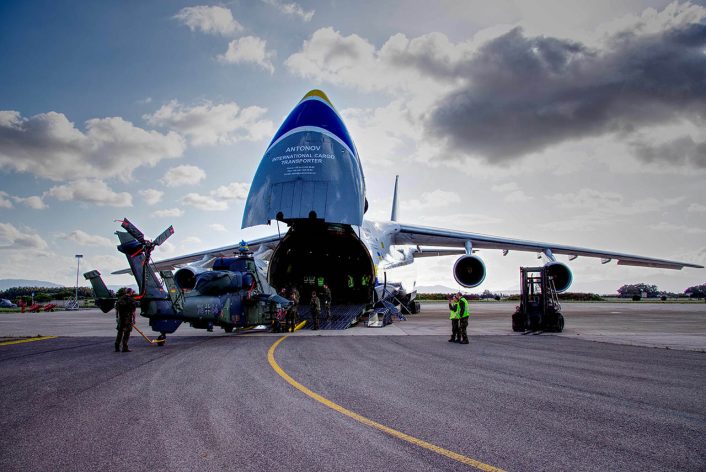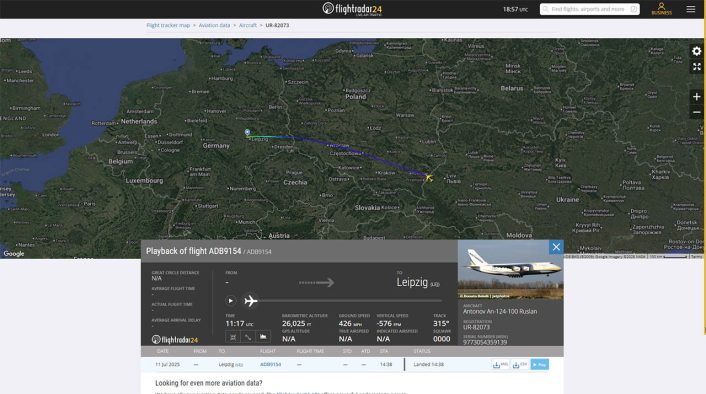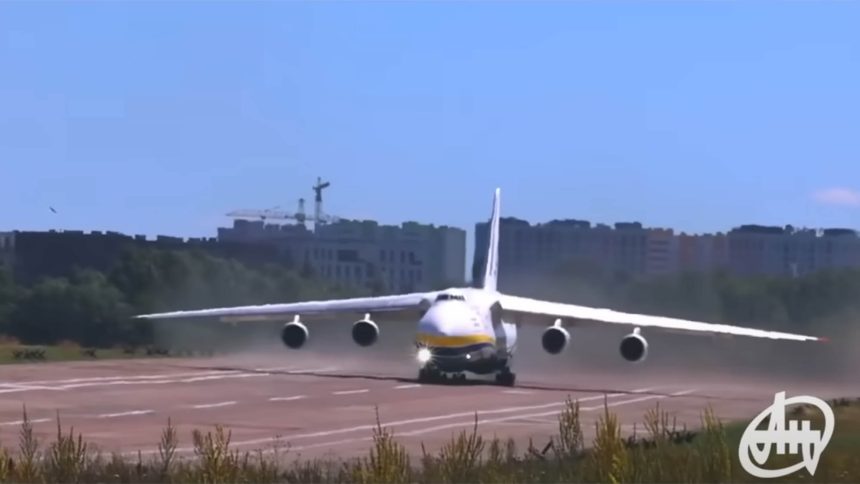One of Antonov Airlines’ prized An-124s, which was undergoing an overhaul at the time of Russia’s full scale invasion, escaped Ukraine’s contested airspace and arrived at Antonov’s temporary base at Leipzig Airport, Germany.
Work on UR-82073, an Antonov An-124-100 manufactured in 1994, was halted as Russia’s invasion threatened to overrun the Ukrainian capital of Kyiv in February 2022. The overhaul process had been ongoing at Sviatoshyn Airfield for some time at this point, leaving the aircraft disassembled and far from flightworthy.
Slightly further out from Kyiv, at Antonov’s main facility at Hostomel, a battle which would become one of the defining moments of the early stages of the invasion emerged between a Russian air assault force and Ukrainian defenders. With a long 3,500 metre runway, Hostomel was a strategic location for Russia to capture in order to support further operations. Ukraine managed to repel several waves of Russian attack, but at the cost of the airfields’ utility as well as the world famous Antonov An-225 Mriya, which was destroyed. The company also lost their sole An-26 and An-74 during the battle.

As the frontlines settled much further towards the internationally recognised border with Russia, the area around Kyiv became relatively safe (albeit still vulnerable to air attack), and work could resume on the An-124. While the An-225, with its enormous carrying capacity, was the pride of Antonov’s fleet, the An-124s are the company’s workhorses. Any An-124s on the ground within Ukraine at the time of the invasion became effectively stranded. There do not appear to be any confirmed total losses of the aircraft, though UR-82009 did suffer damage at Hostomel. Five An-124s, outside of Ukraine on operational flights, were afterwards rehomed at Leipzig Airport where Antonov now runs its transport business.
Demand for Antonov’s An-124s has only increased following the Russian invasion. Not only must their aircraft support shipments of aid and equipment to airports in Europe for onward travel to Ukraine, but external contractors – even Western militaries – requiring the An-124’s load capacity are in abundance as using the Russian owned Volga-Dnepr Airlines’ fleet is no longer an option. In fact, some of these aircraft have themselves become stranded overseas after being seized by local authorities. Discussions are underway regarding the potential for ownership of the aircraft to be transferred to Antonov Airlines.

Securing the return to service of Antonov’s stranded An-124s would, of course, help to relieve this extra burden, but the complicated nature of Ukraine’s airspace where neither side has true air superiority means that any flight would face a certain amount of risk of being shot down.
UR-82073’s flight on Jul. 11, 2025 appeared first on flight tracking services like Flightradar24 as the aircraft approached Ukraine’s western border near Lviv. We, therefore, don’t have data to ascertain whether any measures to reduce the aircraft’s vulnerability were taken before reaching safer airspace. The aircraft may have flown at a lower altitude, reducing the likelihood of detection by hostile radar systems. Additionally, considering the value of Antonov’s fleet to the nation as a whole, there is the possibility that Ukrainian Air Force fighter aircraft conducted defensive missions prior to and during the aircraft’s escape.

Antonov says as part of UR-82073’s overhaul and modernisation, Russian-produced components which can no longer be maintained due to the ongoing war were replaced with Ukrainian-built and Western equivalents. The airframe has clocked over 21,000 flight hours across 5,500 sorties.
The company says that the successful relocation of the aircraft is “a symbol of the stability, professionalism and unity of Ukrainian aircraft manufacturers.” UR-82073 will now join its sister aircraft serving Antonov’s global operations. Antonov refers to their aircraft with the name ‘Condor’, choosing to use NATO’s reporting name rather than the Russian designation ‘Ruslan’, meaning ‘lion’.
АТ «#АНТОНОВ» завершило складний багаторічний проєкт із глибокої модернізації одного зі своїх легендарних транспортних літаків #Ан124-100.
Детальніше – https://t.co/9azGMTAUSU pic.twitter.com/cmWmYQxYhU
— ANTONOV Company 🇺🇦 (@AntonovCompany) July 16, 2025
Commemorating battles along the Irpin River, near Kyiv, early in the war, and the river’s role in helping defend against Russian advances, UR-82073 now displays the phrase “Be Brave Like Irpin” on the fuselage. Adjacent is the Ukrainian Trident (or Tryzub), the national coat of arms that is strongly associated with Ukraine’s independence.
Russian commentators online bemoaned the fact the Russian military were not able to prevent this strategic asset escaping from Ukraine and rejoining the Antonov fleet. The Russian Air Force’s persistent radar coverage over much of Ukraine is questionable following the loss of multiple Beriev A-50 airborne early warning aircraft.
The escape is a source of pride for Antonov and for many Ukrainians as they celebrate yet another ‘win’ against Russia.
In the long term, both Russia and Ukraine have expressed a desire to resume manufacture of the An-124 without support from each other. The Russian Air Force and Volga-Dnepr are tied for the position of largest An-124 operator – though, as mentioned earlier, some of the latters’ fleet have been seized overseas, so their long term status is under question. As the Progress D-18 engines used by the An-124 are manufactured by Russia, any restart of An-124 production by Ukraine would likely be subject to selection of a new engine. Studies have taken place, even prior to the war, with this as an end goal.
Did you know there is a second, partially-completed An-225 fuselage sitting in Ukraine? https://t.co/SWCUK1htQJ pic.twitter.com/2MonEocJWj
— JetPhotos (@JetPhotos) December 8, 2015
For the larger An-225, Ukraine also remains committed to getting this iconic aircraft back into the sky. Crucially, for many years there has been a partially completed airframe at Antonov’s plant which has waited for funding to finally be finished. With the amount of damage to the formerly operational airframe, diverting funds to this second aircraft might be Antonov’s best hope to resurrect the Mriya.









